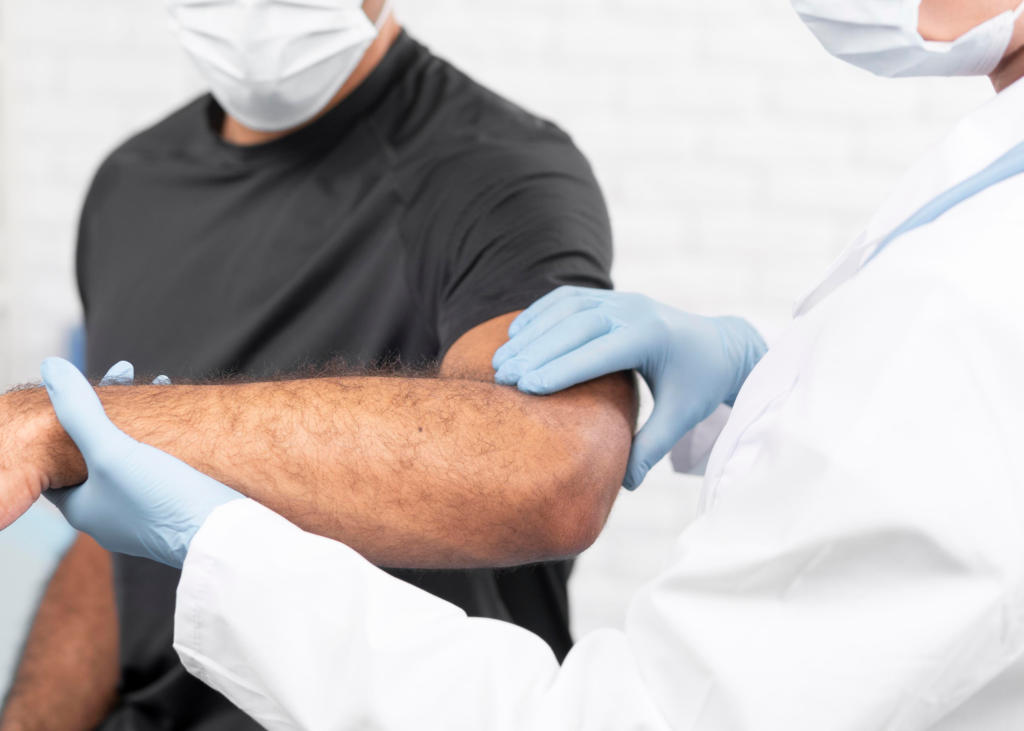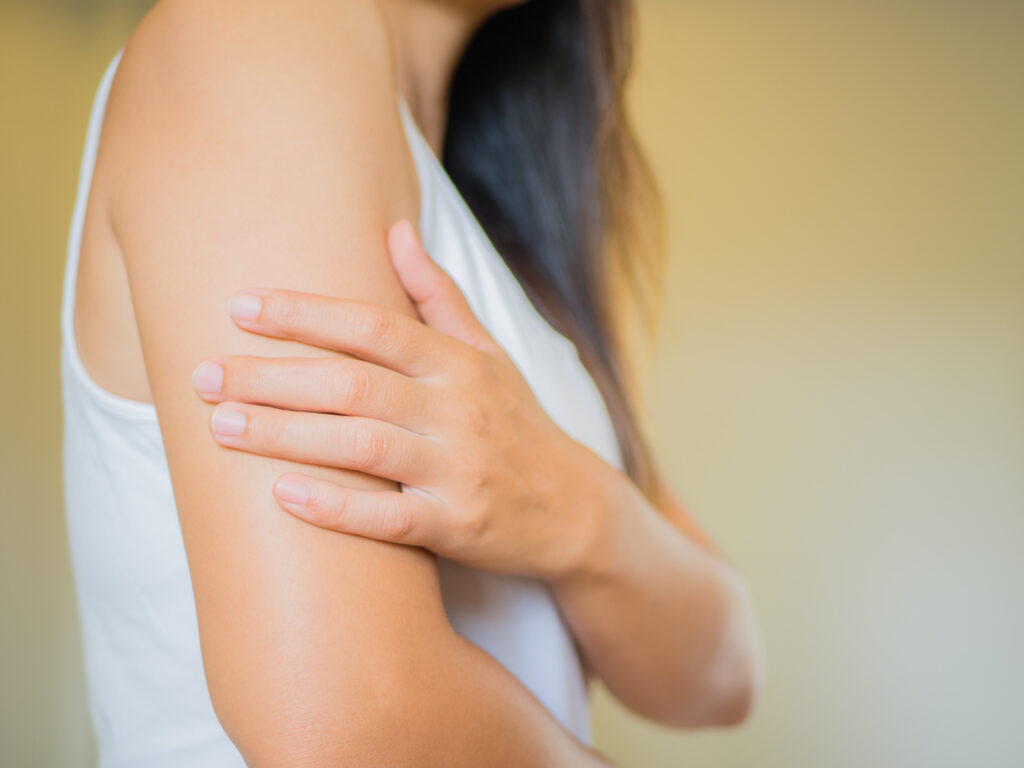
Elbow and Arm Pain After a Car Accident: Common Causes, Symptoms, and Treatment
Arm pain after a car accident is typically caused by direct trauma to the elbow, forearm, or shoulder. The arms may slam against parts of the vehicle or retain the energy of the crash on impact. Common injuries include a broken arm, humerus fracture, and brachial plexus injury.
Many accident victims are surprised to learn how common elbow and arm pain is after a car crash. Whether you tightly grip your steering wheel to brace for impact or ricochet against your car window, several elements of a traumatic accident can severely damage the structures in your arm.
Arm pain can be caused by soft tissue injuries in the muscles and tendons, damage to bones and joints, or impairment of crucial nerves. Below are the most frequent causes of arm pain after a car accident, as well as the symptoms to watch for and medical treatment to anticipate.
What Causes Arm Pain or Elbow Pain After a Car Accident?
Just one car accident can have several mechanisms of injury, especially to the arm or elbow. During a vehicle collision, many accident victims hold onto their steering wheel or throw their arms out in front of them to brace themselves for the crash. Sadly, resisting the impact simply causes the energy of the accident to channel into and damage the wrists, elbows, and shoulders.
Similarly, traumatic accidents often cause a driver or passenger to violently move forward, backward, or side-to-side within the vehicle. When accidents occur at high speed, the vehicle occupants are thrown against other structures inside the car. The steering wheel, dashboard, center console, side window, and airbag are common contact points for injury.
Can Whiplash Cause Arm Pain?
A whiplash injury damages the soft tissue of the neck, including muscles, tendons, ligaments, and nerves. Though whiplash occurs in the neck, it can also cause arm pain or chest pain. Arm pain from whiplash happens when a bundle of nerves in the neck, called the brachial plexus, is overstretched.
The brachial plexus runs from the neck, through the shoulder, and down the arm. When these nerves are damaged, it will cause pain or numbness in the arms, wrists, and hands. Even if you don’t feel neck pain, seek a diagnosis from a medical professional to ensure arm pain is not whiplash.

Common Arm and Elbow Injuries Caused by Car Accidents
Every structure in the arm is connected, from the shoulder and elbow to the wrist. The majority of the arm is composed of three bones, known as the humerus, ulna, and radius. These bones meet at the elbow joint, joined together by connective bands of tissue called ligaments. Soft tissues like muscles, tendons, and nerves help give the arm mobility and strength.
Arm pain after a car accident can be categorized into the forearm, elbow, upper arm, and shoulder injuries. Take a look at the most common arm and elbow injuries caused by car crashes.
Forearm Injuries
The forearm consists of the ulna, radius, and multiple soft tissues like muscle and ligaments. The most common forearm injury is a fracture, a partial or complete break in one or both bones of the forearm. A car accident may also cause a dislocation of one of these bones, where they shift out of their respective place in the arm.
Frequent forearm injuries after a motor vehicle collision include:
- Ulnar shaft fracture – a broken ulna on the pinky finger side of the arm
- Radial shaft fracture – a broken radius on the thumb side of the arm
- Monteggia’s fracture – a broken ulna with a dislocated radius
- Both-bone forearm – fractured or broken ulna and radius
- Pronator syndrome – aggravation of forearm nerves
- Forearm strain – a tear in forearm tendons or muscle
- Forearm sprain – a tear in forearm ligaments
Elbow Injuries
The elbow is made up of a complex joint that connects the ulna and radius of the forearm to the upper arm’s humerus. The elbow has two primary ligaments: the ulnar collateral or medial collateral ligament and the lateral collateral or radial collateral ligament.
Aside from muscles and tendons, three main nerves cross the elbow joint, including the ulnar, radial, and median nerves.
Common elbow injuries after a car accident include:
- Elbow dislocation – a shift in any of three bones in the elbow joint
- Olecranon fracture – a broken tip of the ulna that creates the point of the elbow
- Medial or lateral condylar fracture – a broken joint at the humerus
- Elbow sprain – a tear in one of the three elbow ligaments
- Flexor tendinitis – inflammation of one of the three elbow ligaments
- Olecranon bursitis – inflammation in the fluid sac that protects the joint
Upper Arm Injuries
The upper arm extends from the shoulder joint to the elbow joint. It’s composed of three muscles in the front—called the brachialis, coracobrachialis, and biceps brachii— and one muscle in the back, called the triceps brachii. One long upper arm bone, called the humerus, extends from the shoulder to the elbow.
Frequent upper arm injuries after a car crash include:
- Humerus fracture – a break in the long upper arm bone
- Distal humerus fracture – a break in the upper arm bone near the elbow
- Dislocated humerus – a shift in the upper arm bone
- Bicep or tricep strain – a tear in the main muscles of the upper arm
- Brachial plexus injury – damage to the nerves that run from the shoulder through the upper arm
Shoulder Injuries
The shoulder is a ball-and-socket joint that connects the humerus bone to the glenoid bone (shoulder blade). Also referred to as the glenohumeral joint, the shoulder is home to multiple ligaments, including the superior, middle, and inferior glenohumeral ligaments and the coracohumeral ligament.
Common shoulder injuries from a car accident include:
- Torn rotator cuff – a tear in the shoulder muscles
- Shoulder dislocation – a shift in the humerus or glenoid bone
- Labral joint tears – damage to the labrum of the shoulder
- Shoulder sprain – damage to the ligaments of the shoulder
Brachial plexus injury – damage to the nerves that run from the shoulder through the upper arm

Arm Injury Symptoms to Look Out For
Arm pain after a car accident can indicate an injury to the forearm, elbow, upper arm, shoulder, or neck. Sharp or shooting pain after an accident may be a sign of a severe injury, such as a severe fracture or nerve damage. Though you should always seek medical attention after an accident, arm injury symptoms to look out for include:
- Numbness
- Wrist pain
- Shoulder pain
- Limited range of motion
- Bruising or discoloration
- Swelling or inflammation
- Inability to move the arm or elbow
- Redness or warmth at the injury site
- Muscle spasms in the forearm or upper arm
- Popping or cracking when moving the arm
- Tingling in the fingers, wrist, or elbow
Treating Car Accident Arm Injuries
Treating car accident arm injuries begins with an accurate diagnosis. The majority of common arm injuries are beneath the skin’s surface, so a physical exam and medical imaging are necessary to determine the spectrum of treatment. Minor accident injuries, such as a mild sprain or strain, will likely require rest and ice to heal.
More severe arm injuries may require treatment such as:
- Sling or compression wrap
- Chiropractic adjustments
- Physical therapy
- Pain medication
- Surgery
It is normal for car accident victims to be sore for several weeks, and it’s not uncommon for severe fractures to cause tenderness for months after the incident. When left untreated, an injury such as a dislocation may permanently injure delicate structures, such as nerves. In these cases, arm pain can be life-long—and incur steep medical bills.
Don’t Ignore Arm Pain After A Car Accident
Never ignore arm pain after a car accident. Signs of an injury may appear 24 to 48 hours after the accident, meaning your injuries may be worse than they initially appear. Even severe injuries, such as a total shoulder dislocation, may have delayed symptoms.
By seeking a proper diagnosis and treatment plan right away, car accident victims have a greater chance of fully healing from their injuries. Failing to seek medical attention may only worsen the injury or even cause secondary injuries that permanently reduce your range of motion.
Not to mention, timely action is required to file a personal injury claim for compensation for lost wages and medical bills. The state of West Virginia offers victims just two years from the accident date to file a claim, and missing this timeframe will invalidate your injury claim.

How an Attorney Can Help with Compensation for Arm Pain
If you’ve sustained arm pain or injury due to a car accident that was no or little fault of your own, you deserve compensation for your medical bills, lost wages, and, most importantly, pain and suffering. A personal injury lawyer can help file an injury claim against the at-fault driver’s insurance company and even file a lawsuit if necessary.Do not suffer from arm pain after a car accident alone. An attorney with The Miley Legal Group is ready to help you with a free consultation to determine your next move. Contact us today to take your first steps towards compensation.

